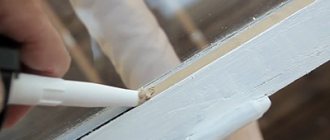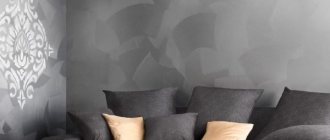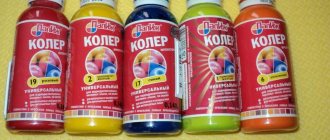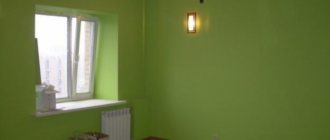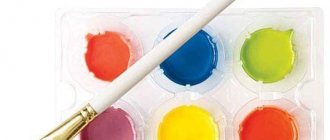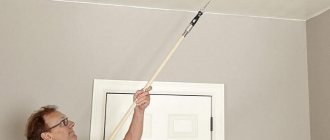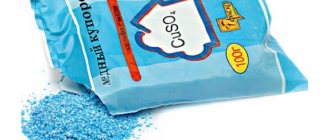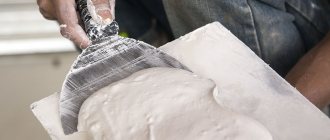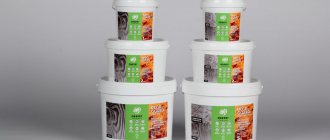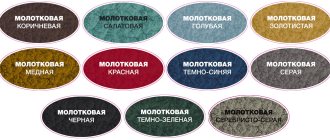What colors should you buy?
Tinting is the name of the science that studies mixing styles and obtaining the desired shade. It is this science that helps to obtain lilac color, as well as fuchsia, ivory, sea wave or sea when mixing colors. In theory, to create many colors, it is enough to have yellow, red and blue. But in this case, you can get a narrow spectrum.
To create a wide palette, it is enough to buy the following colors:
Read also: How to make a podium bed with your own hands
These colors are quite sufficient for applying the basic scales. Gold, silver, mother-of-pearl and other additional colors are also used for artistic decoration of drawings.
Paint mixing table
What color is mahogany?
Mahogany or Mahogany is the name of the color of mahogany. Mahogany hair color is ideal for girls with an autumn color type. Strictly speaking, it is a dark brown color with bright red notes, which does not necessarily look natural. Stylists interpret the shade in different ways.
Interesting materials:
When can mouse hyacinth be replanted? When can peonies be replanted in spring or autumn? When can a remontant Victoria be replanted? When can plum seedlings be replanted? When can you replant thujas in the fall? When can you replant thuja from one place? When can Victoria be replanted? When can you replant strawberries? When can you replant jasmine in the fall? When can I retake the Entry 2022?
Preparatory work
An old surface on which cracks and chips are clearly visible, and for metal - also traces of corrosion - must be thoroughly cleaned and sanded before painting. The fact is that the presence of a metal-containing acrylic pigment will not protect the metal from corrosion, but will only aggravate it, since a layer of bronze paint is not one hundred percent protection from atmospheric moisture.
To remove the previous coating, you can use one of the following methods:
- Mechanical cleaning by brushing using a steel brush or rotary sanding attachment. The method is suitable for flat metal surfaces.
- Sandblasting, in which a metal surface is exposed to grains of sand under high pressure. In this way, you can obtain a cleaned surface of any configuration, but the apparatus itself is relatively scarce and most often has a stationary design.
- Chemical cleaning with special compounds that are applied to the old coating.
- Thermal cleaning, for which a powerful construction hair dryer is used, which increases the surface temperature to values at which the previous paint is separated from the surface. This method is not suitable for antique items, since it can irreversibly damage the configuration of the item.
The dry surface must then be primed using a clear primer.
Dark brown shade
Photo: dark brown shade
The most popular among the brown palette. Can be obtained in several ways.
The first method is based on combining three primary colors - blue, yellow, red in equal proportions. In this case, the paints should not be characterized by an excessively dark shade. For the necessary color saturation, black is gradually introduced.
In the second method, a small percentage of blue or black paint is added to the resulting brown tone until the effect of the desired depth is achieved. The result is a deep, noble shade.
The third method is based on the use of three primary colors of the visible spectrum - blue, red, yellow. For this purpose, it is necessary to take two different dark tones of blue and green, combining them in equal parts by mixing. You need to add red with a small percentage of black to the mixture until the desired dark brown shade is obtained.
Features of receipt:
- if blue, red and yellow paints are used, the latter is added only after thorough mixing of the first components;
- yellow helps eliminate excessive shading and depth;
- dark brown may have a slight purple or green tint.
Painting in several layers
With the help of multi-layer coloring, the effect of an aged object, which was previously often repainted, is achieved. This antique painting of furniture is based on the factorial characteristics of wood and color differences.
The selected primary color is applied to the surface. This layer should be thin, so that the wood pattern is clearly visible. An abrasive tool creates abrasions and the product is painted with a second color. This layer is applied with light, careless strokes.
For additional realism of the color, in some places the second layer of paint is shaded so that the main background appears.
Red-brown or terracotta shade
Photo: red-brown or terracotta shade
It is easy to obtain by combining yellow and red paint with a slight dominance of the latter. A little blue and 0.1% white are added to the mixture to achieve maximum effect. That is, to obtain a red-brown shade, you need to use three primary colors and white.
The basic recommendations for mixing tones are simple - red and yellow are taken approximately equally, the first may be a little more, and then blue is introduced 4 times less than the resulting volume. In practice, the amount of blue can be reduced, and red and yellow can be replaced with ready-made orange. When obtaining red-brown, the emphasis shifts to the red region of the spectral circle.
Aluminum and bronze powder. How to prepare and use metallic paint
Bronze or aluminum powder is used to give the painted surface a look characteristic of metal products. Powders can be easily applied to a wide variety of surfaces and materials: from plaster and plaster surfaces to glass and cardboard. The degree of fastening and strength of the coating depend only on the connecting element used. The binding element for metal powders can be all types of varnishes, many types of adhesives, even gelatin and egg yolk. Depending on the surface to be treated and the required strength of the coating, a transparent or translucent binding element is selected.
The higher the concentration of powder in the varnish, the more similar it will be to real silver or bronze. The optimal consistency would be something resembling thick sour cream. The thinner the coating layer is made, the more durable it will be. A thinner layer has greater ductility and, therefore, durability (this also applies to paints and adhesives). Therefore, application must be done by carefully rubbing the strokes, preferably with a hard brush. When using nitro varnishes as a binder, skill and speed are required. Nitrovarnish dries very quickly and the solution thickens right before your eyes.
When covering simple relief surfaces and objects, the simplest spraying method is often used. Pour a heap of powder onto gauze folded in several layers. We bring together and tie the edges of the gauze, getting a “knot”. With this method of application, hairs and lint are not allowed to enter. The easiest way is to use a foam rubber or lint-free cloth tampon. Apply a thin layer of oil varnish or glue. By shaking the “nodule” over the surface, a simple spraying is performed. Large fractions of powder will linger in the gauze, and the most valuable - small ones - will fall to the surface. Varnish or glue performs only a binding role and does not cover the particles themselves. This coating has a real metallic sheen.
Products with complex relief (for example, baguette frames) are covered in such a way as to deepen and more express the relief. To do this, add a small amount of bitumen varnish or brown oil art paint to the oil varnish. The varnish should remain transparent, but acquire a golden brown hue. The product is positioned so that application occurs at an inclined angle. In this case, the powder will be applied unevenly, the protruding parts of the relief will be more “silver” or “golden”. Having a developed imagination and good artistic taste, you can, having determined in advance the required finished look, paint the product in fragments.
The relief product can be given the effect of old bronze. A layer of powder is applied to the product in any way, then the product must dry completely. Cover the product with liquid bitumen varnish in such a way as to fill all the depressions of the relief. Without allowing the varnish to become covered with a protective film, the product must be wiped with a dry, clean cloth. All surfaces of the relief are wiped with polishing movements, the deeper parts are wiped less thoroughly, and in the largest recesses only varnish deposits are removed. The product should not be used until the bitumen varnish has completely dried. In a similar way, you can achieve the effect of old or “blackened” silver. For this type of treatment, not bitumen varnish is used, but black artistic oil paint diluted in turpentine (for example, “gas soot”). The paint is diluted to the consistency of liquid cream. You can use another composition: add a little printing ink to the oil varnish.
Important reminder: getting aluminum or bronze powder into the bronchi and lungs is dangerous to health. Metal powders can cause allergic reactions, choking, cramps
Powder moves easily with air currents, so you should be wary of drafts.
Borovsky Sergey
Taupe shade
Photo: taupe shade
You can get taupe in a variety of ways. The most popular experiments are with classic brown. White and black are gradually introduced into it, while the first somewhat brightens the finished composition, and a small amount of black adds depth to its gray-brown perception. The result looks quite light, but if you look at it from a distance, it can veer significantly towards gray. When mixing, there should be more white palette than black.
Also, the synthesis of gray-brown is possible by introducing gray pigment into the orange composition. Lightness is normalized to white and then black tones. There is also another alternative - combining an orange base with the addition of blue or black pigments. A clear gray on brown can be achieved by combining orange with violet or magenta, and then adding a small percentage of black to it.
Choosing the right solution
For a long time, any bronze paint had an organic solvent in its structure. Its presence contributed to the spread of an unpleasant specific odor, which significantly limited the scope of such solutions.
Nowadays, thanks to technological progress, water-soluble mixtures containing natural metal pigments have appeared. Acrylates act as binders in such solutions.
Water-based bronze paint (don't be confused - this is not Zinga conductive paint)
Acrylic bronze paint for metal has many advantages:
- Ecological cleanliness and absence of any unpleasant odors. During the drying process, only water vapor is released.
- Relatively low price. Using H2O as a base makes it much cheaper to produce, for example, oil analogues.
- Stunning non-ferrous metal appearance. It is also possible to apply it using the “antique” method, which will create an even greater natural effect.
- Easy to use with your own hands. The application technology is not much different from using conventional paint and is quite feasible for an amateur.
- Moisture insulation. Qualitatively protects metal from rust.
Tip: pre-applied Z inga electrically conductive paint will maximize the protection of iron from corrosion, as it will create a reliable thin-film galvanizing layer.
- High resistance to mechanical stress and ultraviolet radiation. For many years this finish will have its original appearance.
- Long service life. With proper use, at least ten years.
Advice: if there are many fire-hazardous items in the room, it is recommended to additionally use fire-retardant metal paints Polistil. They have the ability to foam when a fire occurs, preventing its further spread.
How to make red
It is possible to make a red color only taking into account the presence of industrial conditions and the participation of special colors in the process. So, when printing, printing houses use strange combinations of dyes to create this color on paper:
- purple and yellow,
- fuchsia and yellow,
- yellow and black,
- blue and orange.
Professionals know the strict proportions of color combinations, sequence and technology. A similar procedure is carried out in textile production when dyeing fabrics.
In painting
While in a printing house it is possible to create a new base color, this will not happen in painting. Even using the same dyes in accordance with the typographic tables will not provide the required result. That is, it is impossible to make red by mixing gouache or another type of paint, and the artist will have to purchase it ready-made. But combining the basic red tone with other colors is only welcome, because through experiments you can get stunning shades.
In computer graphics
To create red on a computer, the RGB system is used. It allows you to build the desired model and get any tone, even a basic one. The development of such programs is carried out by programmers and computer engineers, creating colors using digital codes. There are other similar programs that build models of basic colors, and graphic editors help to diversify the palette of their shades and make the colors pure.
Natural dyes
Not so long ago, people made their own hair dyes, pigments for fabric, thread, knitting wool and other needs. They used dyes that are found in nature. Red color can also be obtained from natural materials. Here are the main ways:
- take bedstraw flowers, combine equal parts with alum, cook for 30 minutes, the result will be a bright red solution,
- mix St. John's wort and safflower flowers, cook in water until the broth becomes thick and has a reddish tone,
- cut the orange lichen, sprinkle it with soda, after 3-4 minutes cherry-colored juice will stand out.
You can even get the red color from a special type of worm that lives in hot countries. But for painting it is better to use store-bought paints, because natural pigments can give unpredictable results. Clothes painted with natural colors fade quickly and leave marks on the skin; this defect can only be corrected by the use of chemical paint fixatives.
Bronze pigments for coatings imitating gold
Bronze pigments are the most realistic filler imitating gold for the production of decorative coatings. Using coatings containing bronze pigments, you can decorate products, giving them the soft shine of a noble metal. Standard pigments:
- Coarse bronze powders for decorative coatings, powder paints, plastics and decoration.
Bronze powders for printing:
- For screen, gravure, flexographic and offset printing.
Niche products:
- Water-based bronze powders, encapsulated bronze powder for areas where temperature stability is required.
How to make it yourself
Manufacturers of paint and varnish products produce several types of bronze paints. Such paints and varnishes are completely ready for use and are applied to the base manually using a brush, roller or spray gun. If you wish, you can make your own bronze dye.
See also Proportions for mixing gouache with PVA glue and how to draw with them correctly
First you need to buy the components from which the composition is made. You can get paint that gives a product or object a bronze look from bronze powder (sold in small bags in hardware stores) and drying oil. This composition is usually used to paint wooden objects and plastered walls.
When making dye, certain rules and proportions are followed. For ¼ powder take ¾ drying oil. The components are combined and mixed well. The main thing is to pour the drying oil into the powder, and not vice versa. Alkyd wood varnish can be used as a binding component in the manufacture of the coloring substance. Usually 50 grams of bronze powder are mixed with 1 liter of drying oil or resin.
Some people even make their own heat-resistant bronze paint. This composition is used to paint stoves, fireplaces, and radiators. To make the dye, organosilicon varnish KO-185 and bronze powder are used. When mixing, the following proportions are observed: 2 parts powder and 5 parts resin. If the composition turns out to be very thick, it is diluted with a solvent.
Using bronze powder and polyurethane varnish you can obtain paint with anti-corrosion properties. This composition is used to paint a metal fence and elements of the front door. The powder is mixed with varnish in a ratio of 1:4. The thick mixture is diluted with a solvent.
Expert opinion
Zakharova Irina Yurievna
Cleaning professional with 15 years of experience. Our best expert.
Ask a Question
It is not recommended to add bronze powder to finished enamels. When introducing powder into the composition, the properties of paintwork materials can be changed for the worse. Bronze powder mixed with ready-made enamels will lose a number of useful characteristics.
Rules and features of application
Bronze paint is no different from any other paint and varnish material. This is a composition that is applied to the prepared surface. The same items are used for application as for conventional dyes. Surface painting is done manually.
The main stages of using bronze paints and varnishes:
- prepare (clean, degrease, prime) the base for painting;
- wait until the surface dries;
- mix the composition;
- if necessary, add solvent or water;
- apply to the surface using a brush, roller, paint sprayer;
- you need to paint the object from top to bottom with vertical or horizontal strokes;
- wait for the first layer to dry and apply the second;
- wait for the composition to dry completely.
The finished bronze paint must be mixed well before use. If the composition is too thick, it can be diluted with water or solvent. The type of thinner is indicated in the instructions, which are usually written on the label. Aqueous acrylic dispersions are usually diluted with water. To dilute varnish-based paints and varnishes, solvents (white spirit) are used.
It is recommended to prepare the surface before painting. Do not paint wet or dirty products and objects. First, the surface must be cleaned of dirt and dust. If the product has been previously painted, it is advisable to remove the remnants of the old cracked coating. If the base is too smooth, it is recommended to sand it with sandpaper. It is advisable to degrease the surface to be painted.
Before applying paint, the base can be treated with primer. The type of primer is selected depending on the surface. There is a primer for wood, concrete, plaster, metal, universal. Priming strengthens the surface, improves paint adhesion, and reduces paint consumption. It is possible to paint products not treated with primer, but it is not advisable.
See also
Description and technical characteristics of EP-773 enamel, application rules
The paint is applied to a dry, clean, prepared base. To apply the composition, use brushes, rollers or a paint sprayer. The thickness of the mixture depends on the painting method. For a paint sprayer, a liquid composition is made (the paint is diluted with a solvent or water). When using a brush, the mixture may be thick, similar to sour cream.
Usually bronze paint is applied in 1-3 layers (no more). The coating should not be made too thick, otherwise it will soon crack. After applying one layer of paint to the surface, wait several hours for it to dry. The drying interval is indicated in the instructions. You cannot apply a second coat over a wet first coat. During the drying process, care must be taken to ensure that no water or dust gets on the surface. The painted product dries completely within 1-3 days.
If you use homemade paint for painting, it is recommended to prepare the mixture before applying it to the base. First you need to mix the powder with varnish, and then dilute the composition with a solvent. For painting use brushes, rollers, and a spray gun.
Description and purpose
Bronze paint is used for decorative purposes. Using paint and varnish, which gives the painted surface a bronze appearance, you can paint products made of wood (frames, crafts), metal (gates), plaster (figurines), and concrete.
The main ingredient of any bronze paint is bronze powder. The powder is obtained from copper or copper alloy. The crushed metal gives the paintwork a brownish-green golden color. In addition to metal powder, the paint may contain resins, varnishes, and polymers. You can make your own dye based on powder and drying oil.
Types of bronze coatings:
- acrylic (for wood, interior work);
- alkyd (for metal);
- oil (for painting);
- adhesive (for decorative finishing);
- with a hammer effect (to give roughness);
- organosilicon (for metal, concrete);
- in the form of an aerosol (for spraying on a relief surface);
- anti-corrosion (for metal fences);
- heat-resistant (for heated surfaces).
The main feature of bronze paint is its versatility. Paintwork materials can be simultaneously used for painting and protecting the surface from the adverse effects of external factors (moisture, mechanical abrasion, damage). Objects and objects painted in bronze retain their original appearance for several years. The durability of the paint depends on its composition. The most durable coatings are those based on organosilicon and alkyd resins.
Precautionary measures
Despite all the advantages, bronze powder paint requires unquestioning adherence to safety regulations. Since this is an explosive substance, it is prohibited to store it in places accessible to open sources of fire. The best option is a place away from the living space and a tightly closed container or container. The work area, if it is indoors, must be well ventilated.
Bronze powder paint - application
You should handle bronze-based acrylic paint with care: contrary to the assurances of the manufacturers, pockets of rust may appear on the surface to be painted even during application.
Bronze-based paint should be applied in several layers so that the previous one has time to dry completely. You should not try to coat with bronze material products that were previously painted with acrylic paint, nitro-enamel or oil-based paints - this will lead to the formation of bubbles and poor quality of painting in general.
Main component of bronze paint
The main element used to obtain a bronze coloring agent is bronze powder. The powder component is obtained by grinding the metal in special mills, resulting in very fine particles. The metal can be either copper or zinc alloys; the use of different types of metal bases allows you to obtain different shades from light golden to red. The paint itself is made from powder obtained from a copper alloy. The specificity of the coloring composition also depends on the size of the metal particles.
To obtain a powder that will have a scaly shape, additives in the form of lubricants are introduced during grinding.
The highest quality powder is obtained by grinding copper alloys.
The powder component is obtained by grinding the metal in special mills, resulting in very fine particles.
Light brown shade
Photo: light brown shade
Any of the above combinations is suitable for the base, for example, a classic ensemble of red, yellow, blue. For a light brown shade of yellow, you should take a little more, and the basic initial paints should be chosen in light colors. The finished composition is additionally clarified with white. How much to add the latter depends on personal preference.
The resulting light brown product may be somewhat reddish, cocoa-colored, lilac or blue. If the tone is too light, you can correct it to a deeper level by adding black to the composition.
How to paint metal like old bronze
Light antique painting is a fairly popular operation when creating various interiors. It is traditionally believed that antique items add an element of sophistication and luxury, emphasizing the style and wealth of the owner of the room. However, genuine antiques are highly expensive and often require restoration and special care. It is much easier to simulate the aging of an object. And today this art is mastered not only by artists, but also by painters and simply amateurs. So, it will be quite possible for you to paint antique furniture if you set yourself such a task. But before you tackle your great-grandmother's chest of drawers, practice on something less valuable.
Benefits of coverage
The advantages of the material come down to two main points - functionality and aesthetics. Reasons why you should pay attention to bronze powder:
Metal powders, what do they give?
- The powder consists of copper, and not its imitation, so the coating actually protects metal surfaces from rust.
- The painted product will last much longer, since bronze paint is highly resistant to moisture.
- Paints and varnishes containing bronze do not fade with prolonged exposure to direct sunlight.
- Powder-based paint is a non-toxic material.
- Objects coated with bronze look luxurious and can become part of a stylish interior in an antique or classic style.
Red in nature
In the color spectrum, red coincides with the minimum frequency of the field visible to our eyes. In the natural environment, this color is found very often. For example, fruits and berries - pomegranate, raspberries, cherries, apples, strawberries. Many of them gave names to various shades of this tone.
https://youtube.com/watch?v=HXq2ngtMBlc
Tomatoes contain a natural pigment that gives them their familiar color, but when it is released without reacting with other substances, it produces a purple color. Contemplation of nature often gives artists the basis for creativity, flights of fantasy, and helps to detail the idea on canvas.
Coloring methods
The method of work is chosen based on the subject itself. There are two types of work: painting smooth and embossed objects. The most commonly used tool for applying paint is a spray gun. To make the coating more flexible, paint is applied in a thin layer, for this it is rubbed over the entire product with a brush or sponge; when using nitro varnish, I use quick movements, because it dries quickly. When working with metal, in order to prevent rust from appearing on it in the future, it is first primed. It is better to choose a soft natural brush.
To make the coating more flexible, paint is applied in a thin layer.
Painting surfaces with complex relief
Relief products require special attention and skill. Indeed, thanks to their bending shapes, the saturation of the paint on them should be adjusted in order to obtain the necessary shadows. To do the job beautifully, it is advisable to have artistic skills. The following recommendations will also help:
- Brown paint from an oil base is added to the oil varnish. The varnish itself, after adding paint, should not lose transparency, but should become slightly golden;
- The surface is completely covered with this mixture;
- The working surface is tilted so that when spraying the powder in large quantities falls on the protruding parts.
This method will help to get a good difference between the protruding parts and the recessed parts.
To do the job beautifully, it is advisable to have artistic skills.
Smooth surfaces are much easier to paint. Painting is carried out as a standard either with a brush, or the products are covered with a can of paint, if this type of paint was purchased. The distance between the product and the spray can should be approximately 20-30 centimeters, it is better to first practice and spray paint on an unnecessary surface to understand the principle of operation and paint the product beautifully and evenly.
The distance between the product and the can should be approximately 20-30 centimeters.
Spraying method
This method is suitable for painting products with simple relief. The work includes a number of actions:
- First, prepare the surface to be painted to obtain good adhesion to the paint solution. It is cleaned of all contaminants; if areas with rust are removed from this metal product, the wood must be sanded.
- Dry bronze powder is poured onto gauze, which is first bent several times. The gauze is tied in a knot.
- The binding component that was chosen for painting work should be painted onto the desired object; it can be applied with a sponge or a lint-free cloth, a piece of leather will do. Make sure that the substance is not exposed to any elements that could give the product an uneven coating.
- Before the binding component hardens on the object, powder is sprinkled on it. The gauze serves as a strainer, allowing only the smallest particles of powder to pass through. By combining with the binding component, the powder is well fixed, so the coating will be durable and beautiful.
The advantage of this method is that the particles of bronze powder are not covered with binding agents, and accordingly the product will be covered with a natural bronze sheen.
This method is suitable for painting products with simple relief.
Coating surfaces with a bronze color can decorate and make them unique, also achieving an antique or antique effect. This way you can create vintage items at home that are now in fashion. This antiquity effect may be appropriate if the interior of the apartment implies the presence of such decor. Working with paint is not difficult, but requires compliance with safety rules due to its explosion hazard. Convenient aerosol paints are available for sale; they are even easier to apply. With this method you can give objects a second life.
Features of black color
Natural black (charcoal) is, in fact, the absence of color - that's what scientists say. This achromatic tone is the complete opposite of white. If the latter reflects an overwhelming amount of light rays, then black, on the contrary, tends to absorb them. There is no absolutely black color in the world, but the darkest vantablack carbon is very close to the “ideal” - it absorbs 99.965% of the rays of the sun, microwaves, and radio waves. That is, this material reflects the minimum possible amount of light, and therefore is considered the blackest on Earth.
Black dye is made from various carbons; it is these substances that make it possible to obtain all types of paints of the desired tone. The most commonly used materials are carbon black and graphite. Previously, artists obtained matte black from burnt bone, and there was no darker tone.
Today, production from minerals has been put on stream, so in any art store you can buy paint, pencil, plasticine or a dark-colored felt-tip pen.
